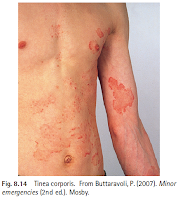Fungal Skin Infections
Introduction
There are few main groups of fungi infecting human.
- Dermatophytes: Dermatophyte skin infections are classed by anatomical location.
- Athlete's foot (tinea pedis)
- Groin infection (tinea cruris or 'jock itch')
- 'Ringworm' of the skin (tinea corporis)
- Scalp 'ringworm' (tinea capitis) - hair loss with inflammation at the affected area
- 'Ringworm' of the nails (tinea unguium)
- Malassezia yeasts
- Pityriasis versicolor
- Candida yeasts
- Cutaneous candidiasis
- Candidal vulvovaginitis
- Oral thrush (oropharyngeal candidiasis)
Athlete's Foot (Tinea Pedis)
Athlete's foot is characterized by itching, flaking and fissuring of the skin, which can also appear white and soggy due to maceration of the skin.
- The usual site of infection is in the toe webs, especially between the fourth and fifth toes.
- The feet often smell.
- Once acquired, the infection can spread to other sites, including the soles and instep of the foot.
- Over time, this can infect the nails, which become discoloured, thickened and dystrophic.
Measures to reduce to transmission
- Not scratching affected skin
- Not going barefoot in public places
- Keeping feet cool and dry (including between the toes)
- Washing socks regularly
Ringworm of the Skin (Tinea Corporis)
Tinea corporis is defined as an infection of the major skin surfaces that do not involve the face, hands, feet, groin or scalp.
- The usual clinical presentation is of itchy pink or red, scaly, slightly raised annular patches with a well-defined inflamed border.
- Over time, the lesions often show central clearing because the central area is relatively resistant to colonization. This appearance led to the term ringworm.
They are usually acquired through direct contact with an infected person or animal (for example, dogs and cats) although indirect contact, such as through clothing, sometimes occurs.
- Advice should be given to wash towels, clothes and bed linen frequently to eradicate the fungus.
Fungal Scalp Infection (Tinea Capitis)
The first sign of infection is the appearance of a well-circumscribed round patch of alopecia that is associated with itch and scaling.
- Inspection of the area might reveal erythema and black dots on the scalp as a result of broken-off hair stubs.
Tinea capitis is treated systemically; additional topical application of an antifungal (e.g. ketoconazole and selenium sulphide shampoos) may reduce transmission.
- Griseofulvin is used for tinea capitis in adults and children; it is effective against infections caused by Trichophyton tonsurans and Microsporum spp.
- Terbinafine is used for tinea capitis caused by T. tonsurans.
- Repeating the culture every 4 to 6 weeks. Continue therapy until the culture is negative and hair has regrown (this may take several months).
Pityriasis Versicolor
Pityriasis versicolor is a common chronic condition caused by Malassezia yeasts, which presents with patchy, sharply demarcated macules with fine scale.
- The rash tends not to itch and shows less inflammation than in tinea corporis.
- The condition is common in tropical climates and is exacerbated by heavy sweating.
Management
- Showering after excessive sweating can help.
- Treat hyperhidrosis if present.
- Pityriasis versicolor can be treated with ketoconazole shampoo or selenium sulphide shampoo.
- Topical imidazole antifungals or terbinafine are alternatives, but large quantities may be required.
Cutaneous Candidiasis
Candida infection of the skin arises as a complication of conditions that make the skin moist or macerated. It occurs in flexures, the submammary area and other skin folds.
- Candida infection usually occurs in patients with predisposing factors (e.g. broad spectrum antibiotic therapy, diabetes, general debility, immune incompetence, obesity, immobility).
- Candida presents as patches of moist, confluent erythema on the skin, sometimes with vesicles and satellite pustules, and often with minimal scaling.
Management
- Keep affected areas dry, and consider using a barrier cream (e.g. soft white paraffin, zinc oxide).
- Use topical antifungal treatment, such as bifonazole 1% cream, clotrimazole 1% cream, miconazole 2% cream or terbinafine 1% cream.
Treatment
Topical imidazole (e.g. clotrimazole, miconazole, ketoconazole, imidazole) or terbinafine would be first-line treatment for superficial, localised fungal infections. Both have similar mycological and symptom cure rates, although terbinafine might be preferred because it clears symptoms in a shorter space of time, although it is more expensive.
- Steroid containing antifungal products should be used for shortest period (maximum: 7-14 days) to control initial symptoms of redness and itch before switching to an imidazole only product.
- To prevent relapse, topical antifungal should be continued for 1-2 weeks after the disappearance of all signs of infection.
Referral to doctor for systemic therapy (e.g. oral terbinafine, fluconazole, itraconazole, griseofulvin) is necessary for
- Scalp infection
- Skin infection that is widespread or established
- Infection that has not responded to topical antifungal treatment
NOTE: Do not use griseofulvin or oral terbinafine for treatment of pityriasis versicolour due to ineffectiveness against Malassezia yeasts. Also, do not use griseofulvin for cutaneous candidiasis because it is not active against Candida albicans.
Summary
Treatment failure of fungal skin infections may occur simply because it was not continued for sufficiently long enough.
- However, if an appropriate topical antifungal product has been used correctly without remission of symptoms, referral to doctor is warranted, especially if the problem is of long duration (several weeks).




Comments
Post a Comment